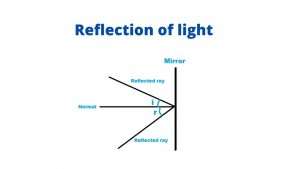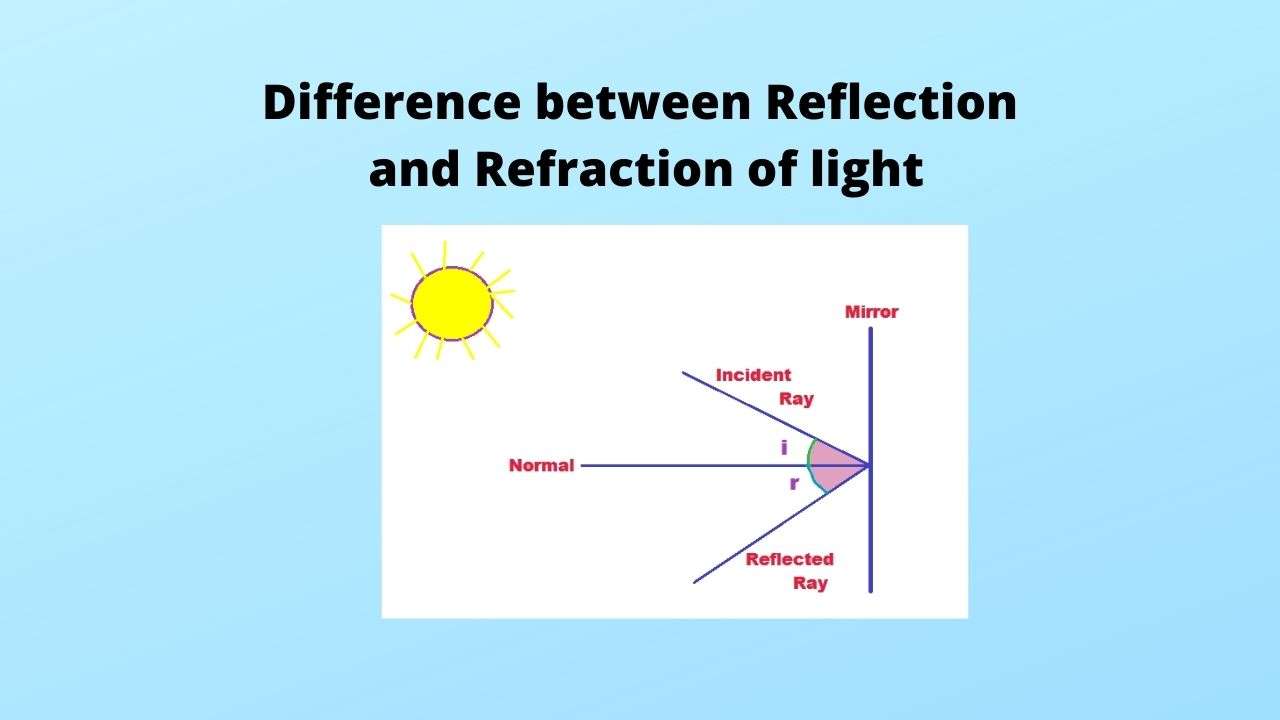Whatever students want to know about the Difference between Reflection and Refraction, those students are reading all the articles, after reading this article you will know what is the difference between reflection and refraction.
You read this article “Difference between Reflection and Refraction” and solve all questions related to reflection and reflection of light. Let’s start with the introduction of the reflection of light. After reading the reflection of light, we will go about the refraction of light. In the last of the article, we will see the comparison of both.
Reflection of light Explain
When light falls on the surface and gets back into the same medium, it is known as a reflection of light. A highly polished surface or mirror reflects the ray of light.
Mirror reflection shows us undimmed images. Images and shadows are very different. Images are clear and true reflections of the objects, whereas shadows give a vague idea of the shape of the object and are always black.
Term related to Reflection of light

Incident ray: The ray of light that falls on the reflecting surface is known as the incident ray.
Reflected Ray: The ray of light which gets reflected back in the same medium from the reflecting surface is known as a reflected ray.
Normal: A line segment perpendicular to the plane of the reflecting or reflecting surface at the point of incidence is known as normal.
The angle of incidence: The angle between the incident ray and the normal at the point of incidence is known as the angle of the incident.
The angle of reflection: The angle between the reflected ray and the normal at the point of reflection is known as the angle of reflection.
Difference between Regular and Diffused reflection
Any surface that is polished or shining acts as a mirror. Some surfaces reflect light more than others. Reflection from smooth and polished surfaces is called regular reflection. Irregular or diffused reflection is a reflection from a rough surface such as paper, clothing, etc.
Laws of reflection
There are two laws of reflection:
- The incident ray reflected ray, and the normal drawn at the point of incidence to the reflecting surface lie in the same plane.
- The measure of the angle of incidence and angle of reflection is equal.
All reflecting surfaces whether smooth or rough, plane or spherical follow the laws of reflection.
Refraction of light
When light enters from one medium into another obliquely, the direction of propagation of light in the second medium changes. This phenomenon is called the reflection of light.
Light travels through transparent substances. Most of the time, the densities of the two substances are different. The difference between densities of substances changes the speed of light. It is faster in rarer substances and slower in denser substances.
A ray of light traveling from a rarer medium to a denser medium slows down and bends toward the normal, and the one moving from a denser medium to a rarer medium bends away from the normal.
Example of Refraction of light
The examples or effects of refraction of light are:
- A coin placed at the bottom of the glass tumbler appears to be raised.
- The bottom of a tank or pond, filled with water appears to be raised.
- When a straight rod a spoon or a pencil, is partly immersed in water, viewed from the sides, they appear to be broken or bent.
- The part of the rod/pencil/spoon inside water also appears thick, if viewed from the side.
- An ink mark or a line drawn on a piece of paper appears to be raised when viewed by keeping a glass slab/glass beaker over it.
Laws of Refraction
There are two laws of refraction. All refracting surfaces obey the following laws of refraction:
- The incident ray, the refracted ray, and the normal interface of two transparent media at the point of incidence, all lie in the same plane.
- The ratio of the sine angle of the incident to the sine of the angle of refraction is a constant, for the light of a given color and the given pair of media. The second law of refraction is also called Snell’s law of refraction.
Sin i/Sin r = Constant
This constant value is known as the refractive index of the second medium concerning the first and is written as n21.
n21 = v1/v2
Where v1 = speed of light in medium 1
And v2 = speed of light in medium 2
The absolute refractive index of a medium is its refractive index concerning vacuum or air.
nm = c/v
Where, c = speed of light in air
And v = speed of light in the medium
Refraction of light in glass slab with parallel faces
The refraction takes place at both the air-glass interface and glass-air interface have the following characteristics:

- When a light ray travels from air to glass, the angle of incidence is greater than the angle of refraction. Hence, the ray of light bends towards the normal.
- When a light ray travels from glass to air, the angle of refraction is greater than the angle of incidence of the glass-air interface, a ray of light bends away from the normal.
- If the angle of incidence is zero that is incident ray is normal to the interface, and the ray of light continues to travel in the same direction after refraction.
- The angle of emergence and angle of incidence will always be equal.
- An emergent ray parallels the incident ray along with the original direction but it will be laterally displaced and the light ray is shifted sideward slightly.
- For the same angle of incidence, lateral displacement is proportional to the thickness of the glass slab.
- For the same thickness of the glass slab, the lateral displacement is proportional to the angle of incidence.
Frequently Asked Questions (FAQ)
Some important questions related to the difference between Reflection and Refraction of light.
- What is the reflection of light?
Answer: A mirror alters the direction of light falling on it. This is called the reflection of light.
- What is the refraction of light?
Answer: When a ray of light enters from one medium to the other medium, it bends its path. This is called the refraction of light.
- What is the angle of incidence?
Answer: The angle between the incident ray and the normal line is called the angle of incidence.
- What is the angle of reflection?
Answer: The angle between the refracted ray and the normal line is called the angle of reflection.
5. What is the main difference between reflection and refraction of light?
Answer: The main differences between reflection and refraction of light are:
(i) In reflection, the angle of incidence is equal to the angle of reflection whereas, in refraction, the angle of incidence is not equal to the angle of reflection
We hope that after reading this article, you have got all the important information related to the Difference between Reflection and Refraction. Apart from this, if you have any other questions related to the Difference between Reflection and Refractionthen you must write it in the comment box below. I will try my best to answer it. Bookmark this article to know all the upcoming updates on the educational Notes.
